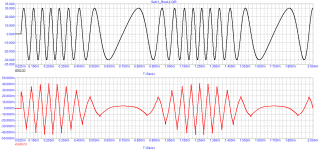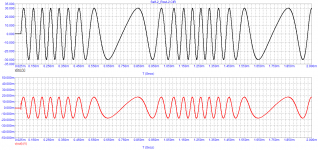THD is just a single point snapshot of the amplifier used as a very rough indication for consumers about the performance of an amplifier. Typical consumers will be overwhelmed when presented with hundreds of measured values, graphs, the works. What benefit would a customer gain from an additiional FCD number? Amplifier designers have no need for FCD since it does not give indicate characterization of the amp not covered by other accepted metrics.I guess this FCD idea ...)
I have already shown, I am showing again
Second picture puts green area around 2nd cycle but claims its how the first looks. Please be more stringent. I don't get it.
//
I mean of course it's unreal (in the audioband and in practice as well) that a signal starts from 0 with an infinite speed (step signal test).
But I guess the very same is exactly true when we deal with just perfectly continuous (amplitude, phase, frequency) sine waves "with history".
In my simulations a 10kHz sine was starting from zero but via a 1k-1n LP filter.
We have been trying to tell you and others that if you want to use a infinite fast' signal with audio you should put it through an audio bandwidth input filter.
The 1k 1n is a start, so I'm happy that finally at least someone is starting to catch up.
Jan
Yes, I got it, my intuition was excessive. I mean there is the phenomenaif you want to use a infinite fast signal with audio you should put it through an audio bandwidth input filter
I thought just the impact looks not too much, as the sims showed.
Try to simulate and/or measure it somehow, what else..?Cortez, there is this thermal related distortion or memory distortion discovered by Gérard Perrot that
engineers still have trouble to measure or simulate, only attempt to minimize. What should we do about it?
Guerilla, none of those who have approached me with a request to help cure a vintage amplifier have complained that they wasted their time on improving the amplifier according to my recommendations. I only get thanks ...
One thing is abundantly clear and fundamentally important to me is that you are honest in conveying what you believe true. What I find tiresome is wasting my time listening to those who, with my undeniable confidence, are blatantly dishonest. With that said please do not take things I say and that can be counter to what you believe true, in any way as an affront to your honesty and integrity. There isn't anything wrong with continuing to defend your position if challenged.
Way above my paygrade. Hopefully fresh minds will discover a way to effectively deal with it rather than mulling over less significant matters.... Try to simulate and/or measure it somehow, what else..?
Hopefully it is not necessary to explain that the output impedance of the amplifier is connected in series with the load and affects the distortion on the load.
As you can see, there is no first period that so annoys many
Here is the behavior of the output impedance of two amplifier options when testing it from the output side:
original scheme of Douglas Self and modified version by Graham (see above)
You do the interpretation of the results yourself, because I misinterpret in the opinion of some colleagues
As you can see, there is no first period that so annoys many
Here is the behavior of the output impedance of two amplifier options when testing it from the output side:
original scheme of Douglas Self and modified version by Graham (see above)
You do the interpretation of the results yourself, because I misinterpret in the opinion of some colleagues
Attachments
I repeat again: the program measures THD only for one specified period. I use microcap, download the user manual and study.Second picture puts green area around 2nd cycle but claims its how the first looks. Please be more stringent. I don't get it.
//
To measure distortions on the 10th period, it is enough to indicate the number of periods of the generator 10. Then the program generates 10 periods and multiplies the 10th period for rendering using the Fourier transform. The program works the same way with the first period, turning it into a periodic signal
arrows, I showed the directions of adding periods to turn the signal into a periodic
I guess the others are saying that: yes that's true, the 2nd one has a less distortion, but that's simplyYou do the interpretation of the results yourself
because the GNFB is a bit faster and that's a basic thing and so the FCD doesn't have any added value.
And we could just say: let's decrease the GD and it will improve the overall performance (if done right).
There isn't anything wrong with continuing to defend your position if challenged.
Basically, yes, as long as you do not make up stuff and represent it as measured or simulated.
Jan
Hopefully it is not necessary to explain that the output impedance of the amplifier is connected in series with the load and affects the distortion on the load.
As you can see, there is no first period that so annoys many
Here is the behavior of the output impedance of two amplifier options when testing it from the output side:
original scheme of Douglas Self and modified version by Graham (see above)
You do the interpretation of the results yourself, because I misinterpret in the opinion of some colleagues
So 30volts input to an amp, and 30mv out? What else have you fudged? The output looks like its slewing, probably input overload. Ild love to see what D Self would say.
Last edited:
What about checking the distortion consistency on every period using the "eye pattern" method?Way above my paygrade. Hopefully fresh minds will discover a way to effectively deal with it rather than mulling over less significant matters.
#141: What is an Eye Pattern on an Oscilloscope - A Tutorial - YouTube
Petrov was asked to send a reasonable signal to the input and demonstrate FCD somewhere not at the beginning of the signal. It seems to be the simplest request.Petrov: what do you say? Can you show an example when there is FCD
present with a normal starting speed signal in a well designed average amplifier?
What does he really do? It sends a signal with an amplitude of 30V to the output of the amplifier and tries to show us something, and does not say what signal it gave and for what purpose. The layout of the axes is such that it is very difficult to calculate manually. I get the feeling that he doesn't know which end of the amplifier is being listened to.Hopefully it is not necessary to explain that the output impedance of the amplifier is connected in series with the load and affects the distortion on the load.
As you can see, there is no first period that so annoys many
Here is the behavior of the output impedance of two amplifier options when testing it from the output side:
original scheme of Douglas Self and modified version by Graham (see above)
I repeat again: the program measures THD only for one specified period. I use microcap, download the user manual and study.
To measure distortions on the 10th period, it is enough to indicate the number of periods of the generator 10. Then the program generates 10 periods and multiplies the 10th period for rendering using the Fourier transform. The program works the same way with the first period, turning it into a periodic signal
arrows, I showed the directions of adding periods to turn the signal into a periodic
It still doesn't make sense what you say. To me you seem confused. Maybe it is that you cant express this in a semantical correct way? I don't know - I feel insecure of your english. I'm not sure that I receive what you may try to convey.
Anyways - you show a first cycle with "distorsion" and then it goes away (?). So lets say there exists a "1st cycle" problem - a first cycle only occurs in the start of every song - say 8 songs per CD. 8 ruined cycles, distributed on 8 different songs - whats the problem. If you just play back that first ruined cycle you wouldn't even har it via a loudspeaker.
"....the same way with the first period, turning it into a periodic signal arrows, I showed the directions of adding periods to turn the signal into a periodic"
"periodic signal arrows"... signal arrows - "arrows".. I don't get what you mean here? Is the word "arrows" in there a typo?
- You claim there is a 1st cycle problem, yet you choose to repeat the "problematic" cycle many (10) times, deviating from the original problem definition - now being a many cycle situation - huh? Is it to be able to do FFT distorsion that you do that? Show a complete sequence of cycles where the problem exists and where/when it goes away. Away? What, it dosen't go away (might your answer be..)??? Well, then you cant call it a *first* cycle problem, now can you?
But I bet you think that if a sequence (1...n) of identical sinus periods at one point is interrupted at say n=13, and that the frequency changes or the level is changed for n=14, you define that sinus cycle N=14 as *the first* - don't you? And as there are no normal music that consist of two identical sinus periods in a row - for you, every singel zero crossing (or whatever - I just winged it
//
Last edited:
Sure Jan. The definition of lying contains a prerequisite of an intention to deceive. I don't believe petr_2009 has any intention to do that.Basically, yes, as long as you do not make up stuff and represent it as measured or simulated.
Jan
- Home
- Amplifiers
- Solid State
- First cycle distortion - Graham, what is that?

